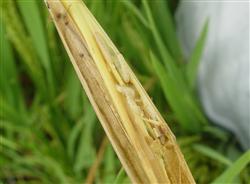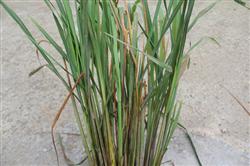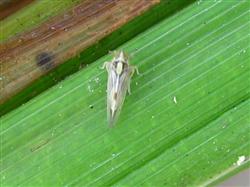How to control rice stem borer?

How to control rice stem borer? Please introduce the control method of Chilo suppressalis, which can be damaged from tillering stage to milk stage, which poses a threat to rice production and affects its yield and quality. It is of great significance to do a good job in the control of Chilo suppressalis, promote the high yield of rice and increase farmers' income. The control methods are as follows: first, damage symptoms caused by the first generation of larvae at tillering stage, resulting in withered seedlings and shoots; damage at booting and heading stage resulting in withered ears and white ears; damage at filling and milking stage caused semi-withered ears and insect-damaged plants, with many blighted grains and easy to turn back. Second, the occurrence characteristics of the second generation in one year in northern Liaoning, the larvae overwinter in rice stubble and straw, pupate in early May, Eclosion in late May, adults move at night, have phototaxis, and like to lay eggs on rice plants with broad leaves, thick culms and thick green growth. the pre-tillering eggs are mostly laid on the front tip of the leaves, and after jointing, they are mostly laid on the leaf tips 2 inches above the water. In the middle of June, it was found that the first generation of larvae ate the leaf tip and withered in the first ten days of July, and the larvae could be transformed into plants, pupated in the stem or leaf tip after maturity, and the second generation larvae harmed the stem in early August. Third, comprehensive control adopts the principle of "prevention first, prevention is more important than control", planting insect-resistant varieties as the basis, rational and timely use of drugs as the key, and adhere to the combination of cultivation measures and chemical control. 1. Cultivation measures to control serious insect pests the rice stubble after autumn harvest should be destroyed, the rice straw with insects in the field should be removed, the weeds on the edge of the field should be eliminated, the intermediate hosts should be reduced, the overwintering larvae should be eliminated, and the source of insects should be reduced. Do a good job in soil preparation in autumn, turning 25 cm deep, resulting in a good soil environment. Strengthen the water and fertilizer management of the paddy field, increase the application of farm manure, re-apply silicon fertilizer, apply silicon and calcium fertilizer 20kg / mu, soak the field for 3 to 4 days before transplanting, and irrigate the first generation pupae in deep water for one week at the peak of the first generation (late June) to reduce the source of the second generation insects. two。 The physical control makes use of the phototaxis of adults, and the trapping effect of black light is better when the stem borer moth enters the epidemic stage. 3. The larvae of Chilo suppressalis (Chilo suppressalis) injured by artificial extraction have the habit of concentration at first and then dispersed transfer. Before the eggs are fully hatched to the larvae, the injured plants are removed and taken out of the field to rett fertilizer, which can eliminate a large number of larvae and prevent the harm of transplants. 4. According to the forecast, about one week after the hatching peak of the first generation larvae (late June), the pesticide was applied when the withered shoot rate was more than 3%, using 20% triazophos EC 100ml / mu and spraying with water according to the instructions; when withered shoots and white ears were seen in early August, spraying 50 kg of water with 18% insecticidal double water agent or 50 g of 90% insecticidal agent per mu or 100 kg of water. Keep 3-5 cm shallow water layer for more than 5-7 days after application. Click to get more rice planting techniques click to get more food crop planting techniques
- Prev

How to control rice brown streak?
How to control rice brown streak? Please give guidance and methods the harmful symptoms of rice brown streak can occur from seedling stage to panicle stage. The disease spot is yellow, initial yellow, and then turns yellowish brown until all rot. Heart leaves fall ill before extraction, can not continue to grow upward and die in the heart, forming a false withered heart, so it is known as heart rot. ...
- Next

How to control rice planthopper?
How to control rice planthopper? Please introduce the control methods of rice planthopper can refer to the following methods: first, reasonable close planting, improve field microclimate, improve rice disease resistance. Second, rational fertilization, control of nitrogen fertilizer, increase the application of phosphorus and potassium fertilizer, skillful application of topdressing, so that early growth and rapid development of rice.
Related
- The first cup of black tea in spring, the flavor and history of tea gardens in Kenya, Africa
- The computer can not only choose potatoes, but also grow tea rice. AI will grow winter oolong tea champion.
- It is not only the inflated tea bitten by insects, but also engraved with the four seasons tea in Beipu.
- The Oriental Beauty Tea Festival in Zhuxian County takes the stage at the weekend to experience the plus-size feast of oil tea.
- & quot; Oriental Beauty Tea & Exploration of Emei in Hsinchu, the hometown of quot;
- The new variety of strawberry "Tainong 1" dessert is the first choice with mellow aroma. Crimson gorgeous
- History of Tea in Taiwan: from Wild Inner Mountain to Export Tea Garden
- Two types of Taiwan Oriental Beauty Black Tea won the British three-Star Award for Childhood Tea Xiang Zhang Jiaqi changed from pilot to champion tea maker.
- Banana species and varieties: the planting history of Taiwan Xianren banana and dwarf banana is long, is banana disease resistant?
- Coffee planting Technology: Qianjie Coffee from Seedling to harvesting

